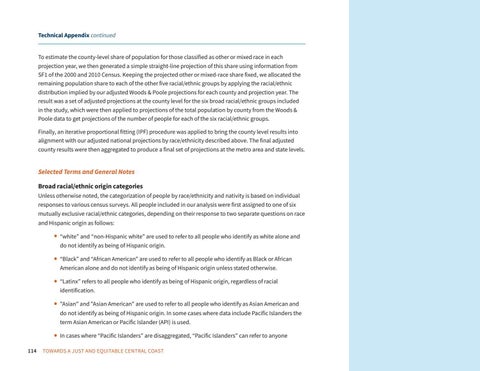Technical Appendix continued To estimate the county-level share of population for those classified as other or mixed race in each projection year, we then generated a simple straight-line projection of this share using information from SF1 of the 2000 and 2010 Census. Keeping the projected other or mixed-race share fixed, we allocated the remaining population share to each of the other five racial/ethnic groups by applying the racial/ethnic distribution implied by our adjusted Woods & Poole projections for each county and projection year. The result was a set of adjusted projections at the county level for the six broad racial/ethnic groups included in the study, which were then applied to projections of the total population by county from the Woods & Poole data to get projections of the number of people for each of the six racial/ethnic groups. Finally, an iterative proportional fitting (IPF) procedure was applied to bring the county level results into alignment with our adjusted national projections by race/ethnicity described above. The final adjusted county results were then aggregated to produce a final set of projections at the metro area and state levels.
Selected Terms and General Notes Broad racial/ethnic origin categories Unless otherwise noted, the categorization of people by race/ethnicity and nativity is based on individual responses to various census surveys. All people included in our analysis were first assigned to one of six mutually exclusive racial/ethnic categories, depending on their response to two separate questions on race and Hispanic origin as follows:
• “white” and “non-Hispanic white” are used to refer to all people who identify as white alone and do not identify as being of Hispanic origin.
• “Black” and “African American” are used to refer to all people who identify as Black or African American alone and do not identify as being of Hispanic origin unless stated otherwise.
• “Latinx” refers to all people who identify as being of Hispanic origin, regardless of racial identification.
• "Asian" and "Asian American" are used to refer to all people who identify as Asian American and
do not identify as being of Hispanic origin. In some cases where data include Pacific Islanders the term Asian American or Pacific Islander (API) is used.
• In cases where “Pacific Islanders” are disaggregated, “Pacific Islanders” can refer to anyone 114
TOWARDS A JUST AND EQUITABLE CENTRAL COAST
